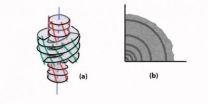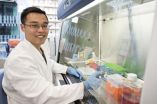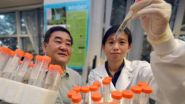(Press-News.org) Switching the polarity of a magnet using an electric field (magnetoelectric memory [MEM] effect), can be a working principle of the next-generation technology for information processing and storage. Multiferroic materials are promising candidates for the MEM effect, due to the coexistence of electric and magnetic orders. On the other hand, the coexistence of spontaneous electric and magnetic polarizations is rare in known materials, which hinders the application potential of the MEM effect. This article briefly reviews a new family of multiferroic materials—hexagonal rare earth ferrites—that have been demonstrated ferroelectric and ferromagnetic simultaneously by experiments. Both the ferroeletricity and ferromagnetism in hexagonal ferrites originate indirectly from structural distortions, resulting in so-called improper ferroelectric and ferromagnetic orders. Naturally, structural distortions may mediate the coupling between the electric and magnetic polarizations in hexagonal rare earth ferrites, causing the MEM effect, as predicted by theory.
The possible MEM effect in rare earth hexagonal ferrites is particularly useful for information storage and processing because the non-volatile nature of the magnetic polarization avoids the energy cost of constant memory refreshing and a constant flow of current. The polarity of magnets are used to store information, for example, in the hard disk of computers. The information is modified by "writing" the polarity using a magnetic field, which requires a flow of current that costs significant amount of energy. If the polarity can be switched using an electric field (the MEM effect), the energy-efficiency will be greatly improved, because the generation of the electric field intrinsically needs less power than for generating a magnetic field. The fact that the electric field can be easily localized also suggests application in miniaturized devices.
INFORMATION:
This research was supported in part by Nebraska EPSCoR. Additional co-authors of the paper are Wenbin Wang from Fudan University.
Corresponding author for this study is Xiaoshan Xu, xiaoshan.xu@unl.edu.
The paper can be found in Modern Physics Letters B (MPLB) journal.
New family of materials for energy-efficient information storage and processing
2014-09-12
ELSE PRESS RELEASES FROM THIS DATE:
Conjecture on the lateral growth of Type I collagen fibrils
2014-09-12
Whatever the origin and condition of extraction of type I collagen fibrils, in vitro as well as in vivo, the radii of their circular circular cross sections stay distributed in a range going from 50 to 100 nm for the most part of them. Jean Charvolin and Jean-Francois Sadoc from the solid state physique laboratory at the Paris-Sud University propose therefore that, once the growth of the fibrils has been triggered by external biological factors, their lateral size be limited by internal physical stresses generated during the growth. Their conjecture is based ...
Extension of standard model by knot algebra
2014-09-12
This paper makes a connection between the quantum group SLq(2), which described knots, and the elementary particles of the standard model. The elements of the fundamental (j = 1/2) representation of SLq(2) are interpreted as creation operators for preons. The preons interact through a preonic vector field defined by elements of the adjoint (j = 1) representation. The leptons and quarks then appear (as required by the electroweak data) as elements of the j = 3/2 representation. Unexpectedly the electroweak quantum numbers of the so defined preons, leptons, and quarks agree ...
Scientists show that nicotine withdrawal reduces response to rewards across species
2014-09-12
Cigarette smoking is a leading cause of preventable death worldwide and is associated with approximately 440,000 deaths in the United States each year, according to the U.S. Centers for Disease Control and Prevention, but nearly 20 percent of the U.S. population continues to smoke cigarettes. While more than half of U.S. smokers try to quit every year, less than 10 percent are able to remain smoke-free, and relapse commonly occurs within 48 hours of smoking cessation. Learning about withdrawal and difficulty of quitting can lead to more effective treatments to help smokers ...
Favoritism linked to drug use in 'disengaged' families
2014-09-12
Before you revive the debate about which sibling in your family is the favorite, you'll want to know what the latest research shows.
Brigham Young University professor Alex Jensen analyzed 282 families with teenage siblings for a study that appears in the Journal of Family Psychology. Favoritism in parenting is a complex topic for sure, but here are some important take-aways.
Does it really matter?
Yes, at least for some families. Jensen looked at perceived preferential treatment in different types of family dynamics. For families that aren't very close to each other ...
Brain inflammation dramatically disrupts memory retrieval networks, UCI study finds
2014-09-12
Irvine, Calif., Sept. 10, 2014 — Brain inflammation can rapidly disrupt our ability to retrieve complex memories of similar but distinct experiences, according to UC Irvine neuroscientists Jennifer Czerniawski and John Guzowski.
Their study – which appears today in the Journal of Neuroscience – specifically identifies how immune system signaling molecules, called cytokines, impair communication among neurons in the hippocampus, an area of the brain critical for discrimination memory. The findings offer insight into why cognitive deficits occurs in people undergoing chemotherapy ...
No innocent bystander: Cartilage contributes to arthritis
2014-09-12
Melbourne researchers have discovered that cartilage plays an active role in the destruction and remodelling of joints seen in rheumatoid arthritis, rather than being an 'innocent bystander' as previously thought.
Dr Tommy Liu, Professor Ian Wicks, Dr Kate Lawler, Dr Ben Croker and colleagues from the Walter and Eliza Hall Institute made the discovery while investigating the role of the protein SOCS3 in controlling inflammation during rheumatoid arthritis. The study was published in the journal Arthritis and Rheumatology.
Rheumatoid arthritis affects more than 400,000 ...
A meta-analysis of 3 types of peer norms and their relation with adolescent sexual behavior
2014-09-12
Researchers at Utrecht University and the New York State Psychiatric Institute collaborated on a meta-analysis of research on adolescent sexual behavior. The goal was to analyze how this behavior is related to adolescents' perceptions of three types of sexual peer norms, including how sexually active their peers are, how much their peers would approve of being sexually active, or how much they feel pressured by their peers to have sex. Awareness that these are different ways in which peers can affect adolescents' sexual behaviors is important for parents, teachers, and ...
Protein appears to protect against bone loss in arthritis
2014-09-12
AUGUSTA, Ga. – A small protein named GILZ appears to protect against the bone loss that often accompanies arthritis and its treatment, researchers report.
Arthritis as well as aging prompt the body to make more fat than bone, and the researchers have previously shown GILZ can restore a more youthful, healthy mix. It also tamps down inflammation, a major factor in arthritis.
Now they have early evidence that GILZ might one day be a better treatment option for arthritis patients than widely used synthetic glucocorticoids, which actually increase bone loss, said Dr. Xingming ...
Dendritic cells affect onset and progress of psoriasis
2014-09-12
Different types of dendritic cells in human skin have assorted functions in the early and more advanced stages of psoriasis report researchers in the journal EMBO Molecular Medicine. The scientists suggest that new strategies to regulate the composition of dendritic cells in psoriatic skin lesions might represent an approach for the future treatment of the disease.
"We urgently need new ways to treat psoriasis, treatments that will deliver improved benefits to patients and reduce the incidence of known side effects for existing drugs," says EMBO Member Maria Sibilia, ...
Gray matter matters when measuring our tolerance of risk
2014-09-12
There is a link between our brain structure and our tolerance of risk, new research suggests.
Dr Agnieszka Tymula, an economist at the University of Sydney, is one of the lead authors of a new study that identifies what might be considered the first stable 'biomarker' for financial risk-attitudes.
Using a whole-brain analysis, Dr Tymula and international collaborators found that the grey matter volume of a region in the right posterior parietal cortex was significantly predictive of individual risk attitudes. Men and women with higher grey matter volume in this region ...





